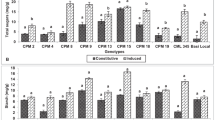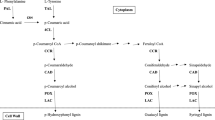Abstract
Variation in performance and abundance of herbivorous insects is attributed to variation in host plant quality, being determined by nutritional composition, allelochemistry and specific anatomical features. Present studies were undertaken to gain an understanding on the role of different biochemical factors in plant defense to Chilo partellus in diverse maize types with variable morphological and favorable agronomic traits. All the white and yellow kernel maize genotypes tested had significantly lower deadhearts and more adverse effects on one or the other biological parameters of C. partellus, as compared to the resistant check, CML 334. The phenolic acids viz., ferulic acid and p-coumaric acid, and the nutritional biochemical factors such as protein, oil, chlorophyll-b, total chlorophyll and total carotenoid showed significant negative correlations, while total sugars and starch had positive correlation with pupal period of C. partellus. Oil content showed significant positive correlation with larval weight, and chlorophyll-a negative correlation with larval and pupal weights of C. partellus. Iron and zinc contents in maize seedlings showed significant positive correlation with pupal weight, whereas zinc content showed negative correlation with plant deadhearts, larval survival and adult emergence of C. partellus. Present studies show that different maize types expressed antibiosis mechanism of resistance to spotted stem borer, while the amount of phenolic acids and the nutritional biochemical constituents were highly variable in their seedlings, suggesting that the maize plant defense against C. partellus could be due to concentration of particular biochemical constituent and/or interaction with different biochemical compounds.

Similar content being viewed by others
References
Agrawal AA (2001) Mechanisms, ecological consequences and agricultural implications of tri-trophic interactions. Curr Opin Plant Biol 3:329–335
AOAC (1970) Official methods of analysts, 10th edn. Association of Official Analytical Chemicals, Washington, pp 744–745
Arnon DL (1949) A copper enzyme is isolated chloroplast polyphenol oxidase in Βeta vulgaries. Plant Physiol 24:1–15
Baldwin IT, Halitschke R, Kessler A, Schittko U (2001) Merging molecular and ecological approaches in plant–insect interactions. Curr Opin Plant Biol 4:351–358
Berbehenn RV, Martin MM (1994) Tannin sensitivity in larvae of Malacosoma disstria (Lepidoptera): roles of the peritrophic envelope and midgut oxidation. J Chem Ecol 20(8):1985–2001
Berbehenn RV, Martin MM, Hagerman AE (1996) Reassessment of the roles of the peritrophic envelope and hydrolysis in protecting polyphagous grasshoppers from ingested hydrolyzable tannins. J Chem Ecol 22(10):1901–1919
Bergvinson DJ, Arnason JT, Hamilton RI, Mihm JA, Jewel D (1994) Determining the leaf toughness and its role in maize resistance to the European corn borer (Lepidoptera: Pyralidae). J Econ Entomol 87:1743–1748
Chang YM, Luthe DS, Davis FM, Williams WP (2000) Influence of whorl region from resistant and susceptible corn genotypes on fall armyworm (Lepidoptera: Noctuidae) growth and development. J Econ Entomol 93:478–483
Chaudhary DP, Kumar S, Yadav OP (2014) Nutritive value of maize: improvements, applications and constraints. In: Choudhary DP, Kumar S, Langyan S (eds) Maize: nutrition dynamics and novel uses. Springer, New York, pp 3–17
Chavan BP, Khot RB, Harer PN (2007) Reaction of maize germplasm to maize stem borer, Chilo partellus (Swinhoe). J Entomol Res 31:187–190
Clegg KM (1956) The application of anthrone reagent to the estimation of starch in cereals. J Sci Food Agri 7:40–44
Cornelissen TG, Fernandes GW (2001) Patterns of attack by herbivores on the tropical shrub Bauhinia brevipes (Leguminosae): vigour or chance? Eur J Entomol 98:37–40
Dhillon MK, Gujar GT (2013) Maize genotypes identified with resistance to spotted stem borer, Chilo partellus and favourable agronomic traits. Ann Plant Prot Sci 21:224–228
Dhillon MK, Sharma HC, Singh R, Naresh JS (2005) Mechanisms of resistance to shoot fly, Atherigona soccata in sorghum. Euphytica 144:301–312
Dhillon MK, Kalia VK, Gujar GT (2014) Insect pests and their management: current status and future need of research in quality maize. In: Choudhary DP, Kumar S, Langyan S (eds) Maize: nutrition dynamics and novel uses. Springer, New York, pp 95–103
Dixon RA, Paiva NL (1995) Stress-induced phenylpropanoid metabolism. Plant Cell 7:1085–1097
Douglas CJ (1996) Phenylpropanoid metabolism and lignin biosynthesis: from weed to trees. Trends Plant Sci 1:171–178
Durbey SL, Sarup P (1982) Ovipositional responses of moths of Chilo partellus (Swinhoe) on different maize germplasms. J Entomol Res 6:1–9
Fincher GB, Stone BH (1986) Cell walls and their components in cereal grain technology. Adv Cereal Sci Technol 8:207–295
Ghasemzadeh A, Jaafar HZE, Rahmat A (2010) Synthesis of phenolics and flavonoids in ginger (Zingiber officinale Roscoe) and their effects on photosynthesis rate. Int J Mol Sci 11(11):4539–4555
Gundappa, Kumar P, Suby SB (2013) Antibiosis effect of phenolic acids (ferulic acid and p-coumaric acid) on maize spotted stem borer, Chilo partellus (Swinhoe) (Lepidoptera: Pyralidae). Indian J Ent 75(3):247–250
Hedin PA, Williams WP, Davis FM, Buckley PM (1990) Role of amino acids, protein and fiber in leaf feeding resistance of corn to the fall armyworm. J Chem Ecol 16:1977–1995
Hiscox JD, Israelstam GF (1979) Different methods of chlorophyll extraction. Can J Bot 57:1332
Huang Y, Sharma HC, Dhillon MK (2013) Bridging conventional and molecular genetics of sorghum insect resistance. In: Paterson AK (ed) Plant genetics and genomics: crops and models, vol 11., Genomics of the SaccharinaeSpringer, New York, pp 367–389
Hung PV, Hatcher DW, Baker W (2011) Phenolic acid composition of sprouted wheats by ultra-performance liquid chromatography (UPLC) and their antioxidant activities. Food Chem 126:1896–1901
Kabre GB, Ghorpade SA (1997) Studies on association of some chemical constituents of maize genotypes with susceptibility of stem borer. J Maharashtra Agric Univ 22:301–304
Kabre GB, Ghorpade SA (1999) Susceptibility to maize stem borer, Chilo partellus (Swinhoe) in relation to sugars, proteins and free amino acids content of maize germplasm and F1 hybrids. J Insect Sci 12:37–40
Kanta U, Dhillon BS, Sekhon SS (1997) Evaluation and development of maize germplasm for resistance to spotted stem borer. In: Mihm J (ed) Proceedings of international symposium on insect resistant maize: recent advances and utilization. CIMMYT, Mexico, USA, pp. 246–254
Kumar H (1992) Inhibition of ovipositional responses of Chilo partellus (Lepidoptera: Pyralidae) by the trichomes on the lower leaf surface of a maize. J Econ Entomol 85:1736–1739
Kumar H (1997) Resistance in maize to Chilo partellus (Swinhoe) (Lepidoptera: Pyralidae): an overview. Crop Prot 16:243–250
Kumar H, Saxena KN (1985) Ovipositional responses of Chilo partellus (Swinhoe) to certain susceptible and resistant maize genotypes. Insect Sci Appl 6:331–335
Mackinney G (1941) Absorption of light by chlorophyll solutions. J Biol Chem 140:315–322
Nelson N (1944) A photometric adoption of the Somogyi’s method for determination of glucose. J Biol Chem 153:375–378
Prasad R, Shivay YS, Kumar D, Sharma SN (2006) Learning by doing exercises in soil fertility: a practical manual for soil fertility. Division of Agronomy, Indian Agricultural Research Institute, New Delhi
Rakshit S, Kaul J, Dass S, Singh R, Sekhar JC, Singh SB (2008) Catalogue of Indian maize inbred lines, Technical Bulletin No. 2008/3. Directorate of Maize Research, Pusa Campus, New Delhi
Rao CN, Panwar VPS (2000) Morphological plant characters affecting resistance to Chilo partellus in maize. Ann Plant Prot Sci 8:145–149
Rao CN, Panwar VPS (2001) Anatomical plant characters affecting resistance to Chilo partellus (Swinhoe) in maize. Ann Plant Prot Sci 9:304–306
Rao CN, Panwar VPS (2002) Biochemical plant factors affecting resistance to Chilo partellus (Swinhoe) in maize. Ann Plant Prot Sci 10:28–30
Rodriguez DB, Kimura M (2004) Harvest Plus handbook for carotenoid analysis, 1st edn. International Food Policy Research Institute, Washington
Santiago R, Butrón A, Arnason JT, Reid LM, Souto XC, Malvar RA (2006) Putative role of pith cell wall phenylpropanoids in Sesamia nonagrioides (Lepidoptera: Noctuidae) resistance. J Agri Food Chem 54:2274–2279
Sen A (1996) Role of conjugated phenolic amines in the resistance of maize towards Sitophilus zeamais and Prostephanus truncates. In: Ananthakrishnan T (ed) Proceeding of the national symposium on biochemical bases of host plant resistance to insects. National Academy of Agricultural Sciences, IARI, Pusa, New Delhi 110 012, India, pp. 125–141
Sharma HC, Taneja SL, Leuschner K, Nwanze KF (1992) Techniques to screen sorghum for resistance to insect pests. Information Bulletin No. 32. International Crops Research Institute for the Semi-Arid Tropics, Patancheru 502 324, Andhra Pradesh, India
Sharma HC, Dhillon MK, Pampapathy G, Reddy BVS (2007) Inheritance of resistance to spotted stem borer, Chilo partellus in sorghum, Sorghum bicolor. Euphytica 156:117–128
van den Berg J (2006) Oviposition preference and larval survival of Chilo partellus (Lepidoptera: Pyralidae) on Napier grass (Pennisetum purpureum) trap crops. Int J Pest Manag 52:39–44
Warnock DF, Hutchison WD, Tong CBS, Davis DW (2001) Evaluating maize for allelochemicals that affect European corn borer (Lepidoptera: Crambidae) larval development. Crop Sci 41:1761–1771
Williams WP, Davis FM, Buckley PF (1998) Resistance to southwestern corn borer in corn after anthesis. Crop Sci 38:1514–1517
Acknowledgments
The authors are thankful to the Director, Joint Director (Research), and Head, Division of Entomology, ICAR-Indian Agricultural Research Institute, New Delhi, for encouragement and providing necessary facilities.
Conflict of interest
The authors declare that they have no conflict of interest.
Author information
Authors and Affiliations
Corresponding author
Additional information
Handling Editor: Joe Louis.
Rights and permissions
About this article
Cite this article
Dhillon, M.K., Chaudhary, D.P. Biochemical interactions for antibiosis mechanism of resistance to Chilo partellus (Swinhoe) in different maize types. Arthropod-Plant Interactions 9, 373–382 (2015). https://doi.org/10.1007/s11829-015-9374-z
Received:
Accepted:
Published:
Issue Date:
DOI: https://doi.org/10.1007/s11829-015-9374-z




